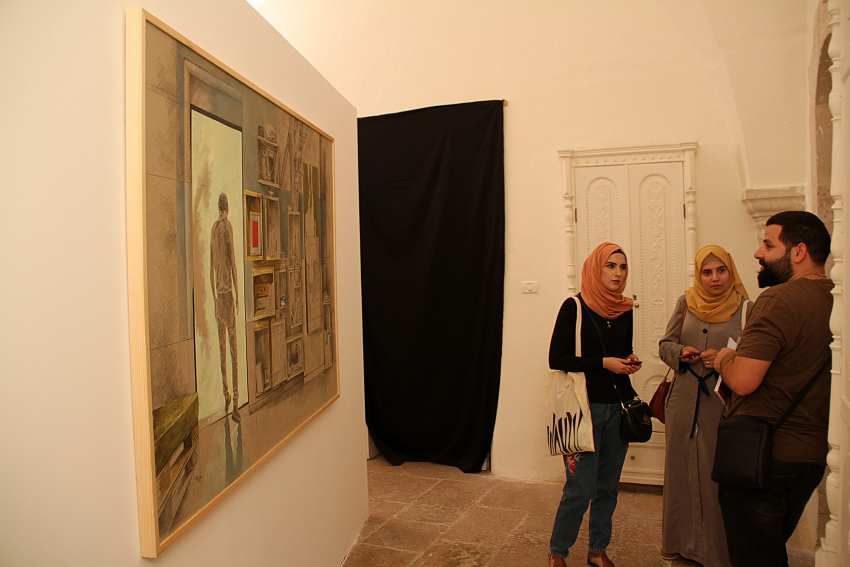

AMQF and The Institute for Palestine Studies, in partnership with the Municipality of Ramallah, organized on Sunday, July 17, 2017, a seminar on the life and work of the late artist Ismael Shammout in the Ramallah Municipality Theater. The event was held at the occasion of the launching of artist Tamam Al-Akhal’s new book, Alyad Tara, Wal Qalb Yarsom (The Hand Sees and the Heart Paints), published in 2017 by The Institute for Palestine Studies. The book narrates Al-Akhal and her late husband’s, Shammout, life story.
Lebanese writer Elias Khouri, artist Khaled Hourani, curator Reem Fidda and artist Samir Salameh all spoke at the event. They presented Shammout’s works and biography and shared some of their personal experiences with the late artist.
During his Skype intervention, Khouri addressed the audience by saying, “The problem you face with Ismael Shammout is his absence; in his journey through color and shape, the man drew his way back from and to the city of Lydda. That is why traces of the road to the stricken city are the only thing you will find in his paintings. And I assure you that you will not meet him, unless you visit Lydda and hear it wail in pain.” He added, “I know that the thirst that has overtaken Lydda has befallen us too, but what I know even more certainly is that the thirst that the Nakba has begotten in me will not be quenched until Ismael Shammout picks up the water jar and drinks. Only then will Lydda retrieve its name, and the exiled their water and story”.
Artist Khaled Hourani said that the seminar was a great chance to have another look at Shammout’s works and read them in light of the present. “Shammout’s works and characters evolved along the years,” said Hourani. “The child Shammout drew in the fifties grew up, and we can see him in other paintings. The man becomes older, and so does the woman. It is as if he was drawing one family with a grandfather and a grandmother, a father and a mother… a family that grows and evolves, as if to represent the cycle of life.”
Curator Reem Fidda also spoke of her personal experience with Shammout and his wife Tamam, “Studying Ismael’s works, I saw that they, for the most part, contained a lot of color and movement”. She added, “Since his early beginnings in 1953, he had always been the ‘young-old’ painter. With time, all characters in his paintings became young, as if he had relied on an eternal young memory that never died”.
Shammout (born in Lydda in 1930) and his wife Tamam (born in Yaffa in the same year) are two of the most prominent pioneers of visual art in post-Nakba Palestine. They held many solo and group exhibitions in several places around the world.
Khaled Farraj, Director of The Institute for Palestinian Studies office in Ramallah, explained that the cooperation the Institute has with AMQF is a longstanding tradition. He added, “The seminar not only shed light on the important artistic and cultural legacy of Ismael Shammout, but also on the political journey of the Palestinian people through the artist’s works”.
AMQF and The Institute for Palestinian Studies cooperate within the framework of “Collaboration”, a programme conducted by the AMQF Public Programme. Through “Tasharok”, AMQF selects one or more local or international institutions to collaboratively design a joint programme and implement public activities based on the institution’s line of work and the common work denominators with AMQF.
The seminar was followed by the opening of the exhibition “A Sight Of Disjunction” in Dar Sa’a in the Old City of Ramallah. The exhibition revolved around the biography of Al-Akhal and Shammout in the former’s book. The book conceals a reading of the paradox of the concept of time.
The exhibition’s theme seeks to part with conventional Palestinian icons, so that a painting becomes a means of modern reflection and a link between different times and works of art. It also opens up the art production process in the studio of an artist that is often absent from art exhibitions.
14 Palestinian artists with different works and styles took part in the exhibition: Amer Shomali, Bashar Khalaf, Bashir Qanqar, Dina Matar, Khaled Hourani, Mohammed Hawajri, Mohammed Joulani, Mohammed Saleh Khalil, Michael Hallaq, Nabil Anani, Ra’fat Asad, Suleiman Mansour, Samah Shahadeh, and Taqiyuddin Sabatin.
A number of students from art schools and other faculties at the universities of Al-Quds and AN-Najjah attended the seminar and the exhibition opening. “It is vital for students to be part of this larger cultural environment,” said Ahmad Al-Hajj Ahmad, a teaching member at the Faculty of Fine Arts in An-Najah National University. He added, “This was a great chance [for students] to learn about Ismael Shammout’s work, especially thanks to the participation of various speakers and the historical presentation of the artist’s works and personal life details with his wife, Tamam”.
The exhibition’s curator and programme coordinator at the AMQF Public Programme, Abdel Rahman Shabaneh, said, “This was my first experience producing an exhibition, and it was very important for me to connect with the artists, as well as observe the development of the exhibition’s theme and the featured artworks”.
Commenting on the event, artist Nabil Anani noted that the idea of the exhibition encouraged the participating artists to work on a specific theme, each in their own style. Anani added, “Another important element was that the artists were of different ages and that the main idea was based on a painting by Shammout, where he had drawn his studio. In the painting’s background, we can see other paintings of his children and wife”.
The exhibition ran until August 1, 2017.

